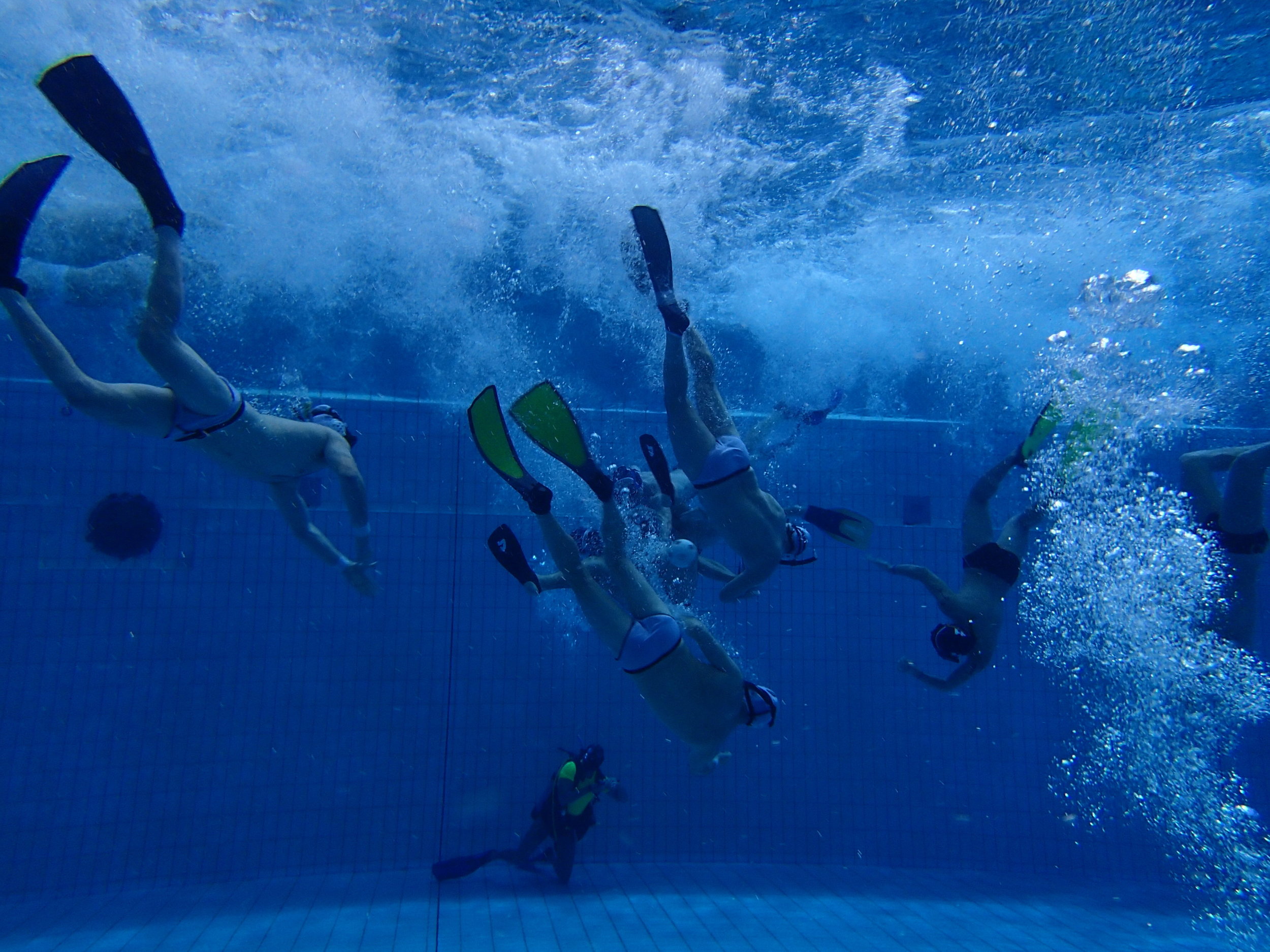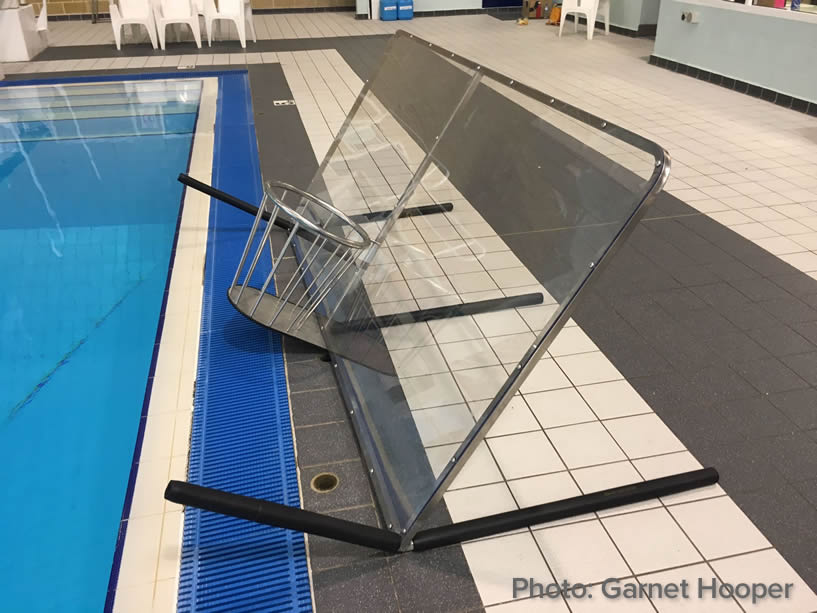What is underwater rugby?
Underwater rugby is a full contact sport played in a deep pool with two teams of players aiming to score goals by placing the ball into the opponent's basket, located at the bottom of the pool at each end of the playing area.
This video, produced by Stian Håland (UNSW Whales), provides a detailed overview of the sport of underwater rugby and how it is played.
How to play underwater rugby
equipment
Underwater rugby players will need the following equipment:
Diving mask (preferably low profile with wide peripheral vision)
Snorkel (preferably with no purge valve)
Fins (Plastic, fibreglass, rubber)
Water polo cap and swimmers
Neoprene socks (optional, helps avoid blisters from wearing fins, and can improve fitment of fins)
Fin keepers (optional, helps avoid fins being pulled off during play)
Playing area
Underwater rugby is played in a deep pool (3.5 - 5 metres in depth), in a rectangular court between 12 - 18 metres in length and 8 - 12 metres in width. In Europe, the deep ends of lap pools are usually suitable for underwater rugby, however in Australia, we usually play in diving pools, and use specially-constructed walls to mitigate the sloped walls prevalent in many Australian diving pools.
The solution to sloped diving pool walls in Australia. These walls were built by the Perth Raiders for use at the UWR National Championships in Perth, 2017.
There are stainless steel baskets mounted at the bottom of the pool at each end of the playing area.
PLAYERS
Six players on two teams are in the water, with up to six substitutes on the exchange bench who can swap with another player at any time in the game, as many times as desired.
The objective for the six players in the water is to take the saltwater-filled rubber ball and score in the opposing team's basket, and defend their own goal against the opposition's attack.
There are three player positions in underwater rugby: forward, defender (or back) and goalie (or goalkeeper). Each position is unique and requires a specific set of skills. The forward's aim is to exploit opportunities to gain possession of the ball, and lead the attack on the opposition's basket. During a defensive play, the defender sits in front of the basket and aims to prevent the opposition from approaching the goal. The goalie lies on top of the basket to block open attacks on the goal.
gameplay and Rules
A game usually lasts for 10-15 minutes per half (depending on individual tournament rules), and each team can request one sixty-second time-out per half.
Deck referee making a call at the Brisbane Pan Pacific Cup 2017.
There are three referees - one on the edge of the pool officiating time and surface play (deck referee), one on scuba observing bottom of pool play, and one freedive referee who observes the game and liaises with the deck referee. The referees have buzzers which produce signals that are audible to players both underwater and on the surface.
The rules of underwater rugby are fairly simple. The player with possession of the ball is allowed to attack any other player, but other players may only attack the player with possession of the ball. Attacking around the neck and the head, twisting limbs, kicking and hitting are not allowed, and are punishable if it occurs.
Official CMAS Underwater Rugby rules →
Fitness requirements
At a competitive level, underwater rugby is physically demanding and requires strong swimming and endurance, strength and power, spatial awareness, and teamwork. However, just being strong will not guarantee results - players must use a mixture of physical ability with strategic and tactical play.
Injuries in underwater rugby are uncommon and are usually limited to bleeding noses or bruises - the water will absorb and lessen impacts. Drowning is also almost impossible, and there are always at least eleven other 'lifeguards' in the pool who can help if a player is struggling.
history of underwater Rugby
Underwater rugby was invented in Köln (Cologne), Germany in 1961 by Ludwig von Bersuda, a member of the German Underwater Club. Using saltwater balls and a volleyball net in the middle of the pool which players had to swim under, the Underwater Club in Cologne played the game to warm up before their normal dive training. The sport, known as the "Cologne Discipline", was adapted into the current form of underwater rugby, sans volleyball net, by the Duisburg diving club. The 'premiere' game of underwater rugby was played in 1964 between Duisburg and the Mülheim diving club. The first tournament, dubbed "The Battle for the Golden Ball", was played in Mülheim the following year, with six teams participating.
Scandinavian countries soon adopted the sport after demonstrations in Finland and Denmark in the 1970s, and it quickly spread to Sweden and Norway, as well as Eastern European countries such as Czech Republic and Poland.
CMAS, the governing body of underwater sports, officially recognised underwater rugby in 1978, and the first European championships took place that year in Malmö, Sweden. The first World Championships was held in Mülheim, Germany in 1980, and subsequent World Championships have been held every four years since.
underwater rugby in australia
Early training session in Sydney with milk crates used as goals.
Whilst UWR has been played around the world for decades, it is still a relatively new sport in Australia.
The first club was formed in 2007 by Celine Steinfeld at the University of New South Wales, who learned about the sport whilst on international student exchange in Sweden in 2004. Celine brought a backpack full of filled UWR balls from Sweden and in the early days, milk crates were used as makeshift goals. An annual tournament, Steinfeld Cup, is held in Sydney, named in honour of Celine's contribution to the establishment and growth of the sport in Australia.
In the past decade, teams have formed in Adelaide, Brisbane, Canberra, Hobart, Melbourne, and most recently, Perth. There are estimated to be almost 300 underwater rugby players in Australia today.







